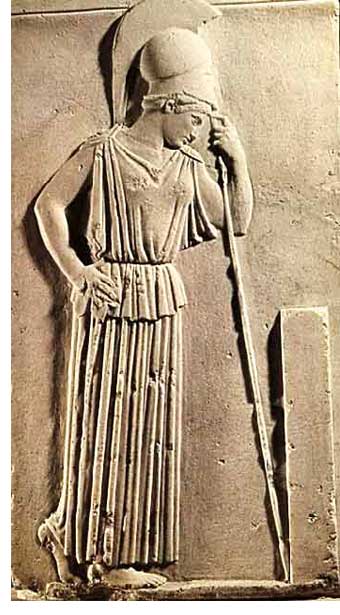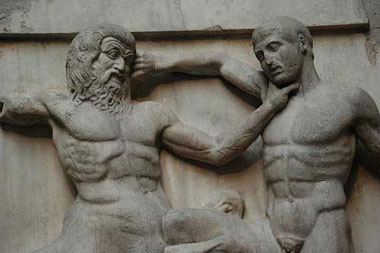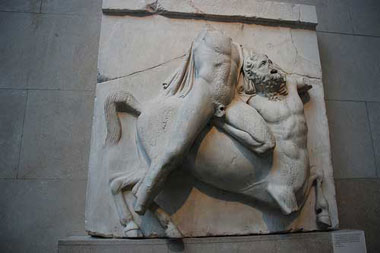Acropolis: The Greek Parthenon


The Parthenon was a dedication of the Athenians to the protectress of the city, Virgin Athena, for the salvation of the city and the victories of Athens against the Persians. It was built during 447-438 BC and it belonged to the big construction program of Pericles which expressed the grandeur of the Athenians in its greatest peak.
It is the biggest temple of classic antiquity with 8 x 17 pillars and the climax of the Doric order which coexists with the Ionic element of the frieze with the Doric pillars. The proportion is 4 to 9 repeated in different parts of the temple.
The pillars present reduction and tension. By reduction we mean the decrease in the diameter of the pillar from bottom to top. In contrast, the tension observed in every pillar at about 2/5 of its length, where the pillar strengthens its force to keep the weight of the entablature. With these architectural innovations the big creators gave breath and movement to the marbles showing power which resists the weight.
The ancient Greeks had confirmed that straight lines give the impression of descending curves under the light of the sun. Iktinos and Callicrates built all the ascending lines of the Parthenon with a slight curve in the center to avoid this illusion. Theses curves range from 6 to 17 centimeters (on the long sides). The curving starts from the foundations of the temple and moves on to the sill, entablature, ceilings, roof and tiling.
The pillars which have a slight inclination towards the internal part of the temple and their entablature step on the horizontal, slightly curved lines and support the building. The corner pillars participate in the inclination of both sides and thus, the perfect balance and symmetry of the Parthenon is achieved.
The chryselephantine statue of Goddess Athena, created by Feidias, was found inside the temple and unfortunately it has been lost. Athena was presented armored but peaceful, human and goddess-like all at the same time.
The metopes show the battle of the Giants (Gigantomachia) on the east side, the battle of the Centaurs on the south (Kentavromachia), the battle of the Amazons (Amazonomachia) on the west and the conquest of Troy on the north. The eastern frieze is the most ancient and it presents the birth of goddess Athena. The central figures were lost during the first Christian years. The western frieze which is the more advanced as far as technique is concerned shows the myth of the dispute between Poseidon and Athena. The central figures were crumbled in the effort of the Venetian Morozini to take them and move them to Venice. The best preserved pieces of the friezes are now exhibited by the British Museum. Fragments and a unique complex (probably of Cecrops and Pandrosos) are exhibited in the Acropolis Museum. The frieze sculptures were among the most beautiful works a human hand has ever made.


Outside, the wall of the cella was decorated with the incomparable Ionic frieze presenting the Panathenaean procession. Mortal and immortal move on walking or riding praising the democratic Athens. The frieze of the Parthenon is a landmark for the history of art and human civilization.
The Parthenon is set to fire probably by the Erouli in 267 AC. During the 6th century it is turned into a Christian church and during the Frankish rule (1205-1456) it operates as a catholic church of the Madonna till it was blown up by Morozini in (1687) when it was operating as a mosque. In the beginning of the 19th century it is dismantled by the English diplomat, Elgin. The reconstruction of the Parthenon which has started from 1980 follows the highest specifications and standards, befitting a unique monument of global legacy.
Walkway: This name was established during the ancient times to describe the road-trail which surrounded the hill of the Acropolis. It had a length of 900-930 metres.
Its beginning was at the junction of Panathenaea street, then it was passing in front of the slopes of the sacred rock where the oblations were set, crossing the theatre of Dionysos, passing in front of the Asclepieion and ending up in the upward access point of the Acropolis.
Today we reach the beginning of the walkway by going down the Acropolis and turning right towards the northern slope.





